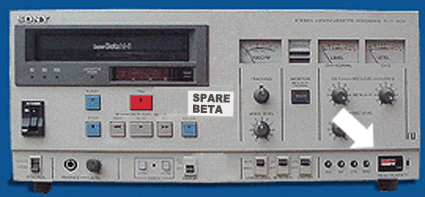

|
Each SLO-1800 has an hours of operation meter (or mercury clock) that displays the amount of time that has accumulated on the video heads. The way it works is each time the video disk makes a rotation it sends a signal (pulse) to the CPU that it is spinning at the right speed. This pulse is piggy backed to a circuit that pops a spark across the gap between the two ends of the clock. Each spark moves a few atoms of mercury across the gap from one side to the other. This gap is visible left of center in the lower photo. The gap then moves as the mercury piles up as mercury is taken from one side to the other. The rate is relative to the rotation. If the gap runs out the clock is finished but it can be reverse before that happens. The switch above on the right reverses the direction so the clock can be used indefinitely. All you had to do was remember to switch direction before it gets to the end. Unfortunately towards the demise Beta duplication these clocks tended to be ignored and ran out. I was fortunate in that most of the units I was able to purchase for refurbishing were ones that were spares or back-up at a well know movie production company. Each had low hours registered on them. The sample in the picture most likely had a real three times 200 hours (X200H) or 600 hours of use on it's video heads. Average heads life expectancy is unknown, it depends on the media (tape composition) used and the maintenance of the machine. The single gap video heads in the SLO-1800 are located within a cavity and are more protected than consumer designs. This is purposefully done to give them longer life and make them easier to clean. 600 hours should indicate very low usage.
©Misterßetamax go to homepage |
|